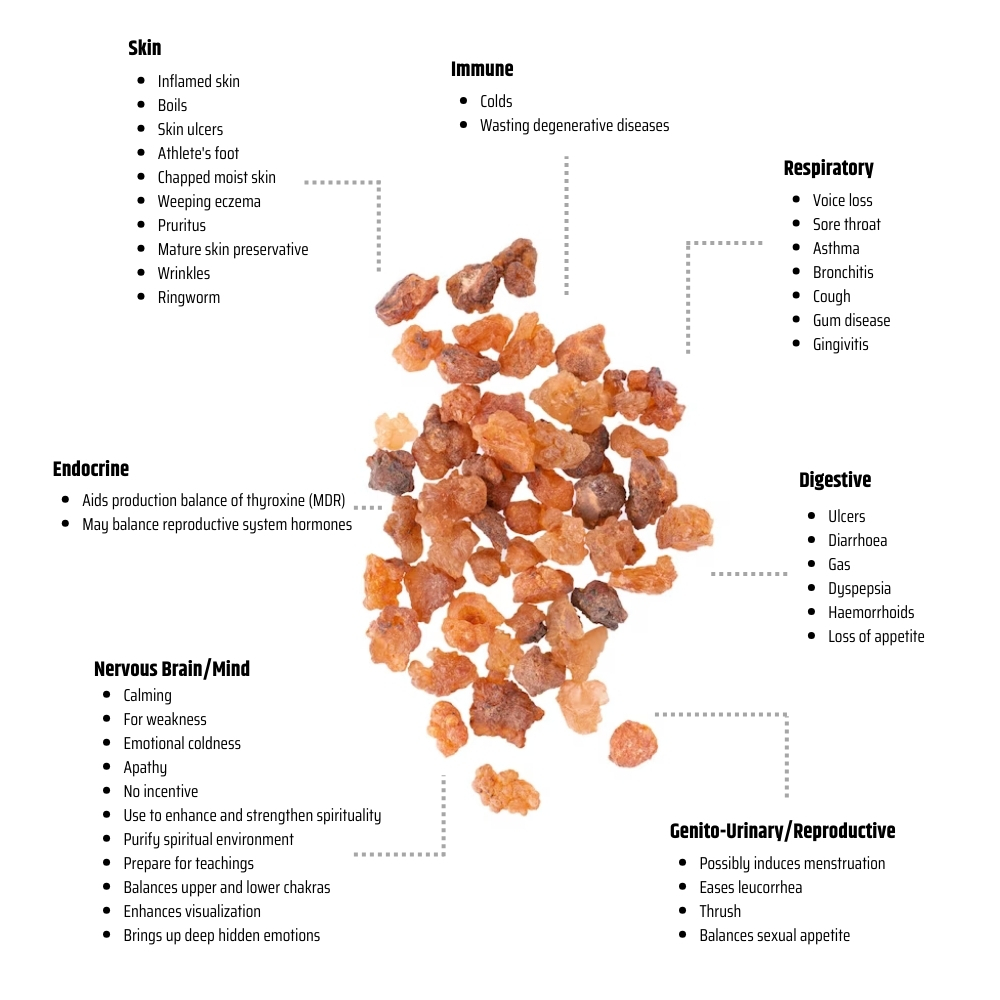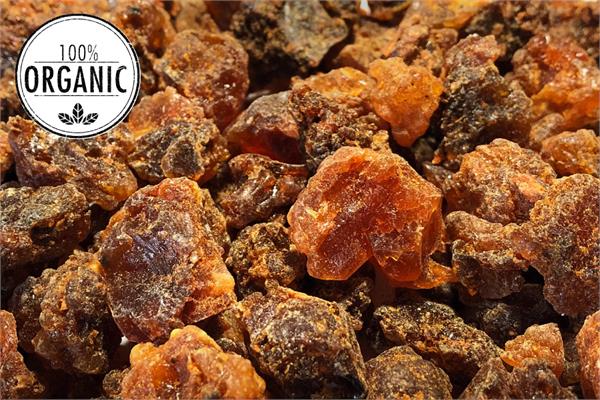
Australian Owned and Operated We have been proudly running for over 30 years

100% Pure & Natural Our products are sourced from the highest quality suppliers and growers from around the world

Not Tested on Animals None of our products are tested on animals

Vegan Friendly Our products are plant based and vegan friendly
Organic Myrrh
Commiphora myrrha
Source: Organic Resin
Origin: Somalia
Energetics: Yang
Extraction Method: Steam Distilled
Scent: Warm, earthy, and resinous, with subtle hints of wood and spice
Blends Well With: Tea Tree, Lavender, Frankincense, Rosewood, Thyme and Rose
About
Myrrh essential oil, derived from the resin of the Commiphora myrrha tree, holds a rich history of use dating back thousands of years. Revered for its deeply earthy and resinous aroma, myrrh oil has been cherished for its therapeutic properties. It is renowned for its ability to promote relaxation, soothe the mind, and uplift the spirit. In addition to its aromatic qualities, myrrh oil is prized for its potential skincare benefits, including moisturising and rejuvenating properties.
Ayurvedic Uses
In Ayurveda, myrrh essential oil, known as "Bola," is highly esteemed for its potent therapeutic properties. Myrrh oil is commonly used to balance the "Vata" and "Kapha" doshas, aiding in grounding and calming the mind and body. Its believed to promote spiritual awareness, meditation, and emotional healing. Myrrh oil is also valued for its anti-inflammatory and antiseptic properties, making it beneficial for promoting oral health and supporting wound healing.
Historical Snippets
Myrrh, among the trio of oils presented to infant Jesus by the Magi, holds significant religious significance. Its usage remains prevalent in Roman Catholic, Eastern, and Oriental church ceremonies to this day. Renowned for its remarkable preservation properties, Egyptians employed myrrh extensively in the mummification process, as well as in perfumery, incense, medicinal, and skincare practices. Legend has it that ancient Greek soldiers carried myrrh in their pouches during wartime, having discovered its wound-healing capabilities.
Key Constituents
- α-Pinene
- Limonene
- Eugenol
- Cresol
- Cadinene
- Cuminaldehyde
- Sesquiterpenes
How To Use
Diffuse: Add a few drops to a diffuser to disperse around the room
Topically: Dilute essential oil with any carrier oil at a 2.5% ratio. This equates to 2.5ml essential oil/oils in total mixed with 100ml of chosen carrier oil. 1ml of essential oil is approximately 20-22 drops of oil. Decant into a roller or glass bottle with eye dropper to apply easily or a larger bottle if using for massage. Please note this dilution rate is for adults and children over the age of 6. More information on children and essential oils is on our blog page. Essential Oils should not be used directly on the skin without mixing first with a carrier oil
Inhalation: Add 1-2 drops essential oil to a tissue and inhale at a distance while ensuring that the oil does not come into direct contact with the skin. Alternatively, you can smell the oil directly from the bottle.
Shelf Life
Our freshly decanted Organic Myrrh will last for 3-4 years minimum from when you open your amber glass bottle if stored correctly.
Primary Storage Considerations: Keep away from direct light (U.V. radiation). Keep in the amber glass bottle with lid tightly closed. Only open when you need to and decant into a smaller "working" amber glass bottle if possible (and label so you know what is in it). This is to reduce oxidation.
Secondary Storage Considerations: Keep in a refrigerator at around 4 degrees celsius.
Safety
General
Some essential oils may cause photosensitivity to the skin - Use diluted in Jojoba or other complete carrier oil.
Do not ingest essential oils.
Do not apply to eyes, sensitive areas or mucous membranes.
The information on this website is not intended to be used in the diagnosis, treatment or mitigation of any physical or mental illness. Ahimsa Oils offer no advice or recommendations only general information. No therapeutic claims are made within.
Pregnant women, nursing mothers and children should not use essential oils without first consulting an appropriately trained healthcare practitioner.
The statements on this website have not been evaluated by the TGA. David Bosley however worked for a long period in consultation with the TGA to ensure correct labelling with reference to the Ahimsa Oil product range.
Specific
Hazards: May be fetotoxic, due to b-elemene and furanodiene
Contraindications: Pregnancy, lactation
References
Tisserand, R., & Young, R. (2014). Essential Oil Safety: Second edition



 Available for $100 orders and over
Available for $100 orders and over

